Introduction
Front
{{section_header}}{{section.name}}{{/section_header}}

Back
{{section_header}}{{section.name}}{{/section_header}}

Sides
{{section_header}}{{section.name}}{{/section_header}}

Top
{{section_header}}{{section.name}}{{/section_header}}

Bottom
{{section_header}}{{section.name}}{{/section_header}}

In the Box
{{section_header}}{{section.name}}{{/section_header}}

The Fuji T300 comes packaged with:
*rechargeable lithium-ion battery NP-45A
*battery charger
*plug adapter
*hand strap
*USB cable
*CD-ROM
*owner's manual
Color
{{section_header}}{{section.name}}{{/section_header}}
We found the T300 posted a color error of 3.45 in our tests of its standard color mode, with a saturation level of around 97% of the ideal. Those are decent numbers, and we found the camera had the hardest time in reigning in blues and magentas, as they tended to be oversaturated. The T300 did very well with skin tones and foliage in this mode, however. More on how we test color.
The Fuji T300 was bested in our comparison group by just about every model we put it up against, though it lands in a virtual tie with the Casio ZR100. The Samsung PL210 and the Fuji F600 (admittedly a more expensive model), both managed to offer more accurate colors across the board.
Color Modes
{{section_header}}{{section.name}}{{/section_header}}
The only three color modes available on the T300 are standard, chrome, and monochrome. The chrome mode was less accurate than standard, with its best shot having a color error of 4.09 and a saturation level of 96% of the ideal. We found chrome provided a great deal of variance, however, as one test shot returned an error of 4.89 with saturation boosted all the way up to 119% of the ideal, in a shot taken literally just seconds after the first one. With no change in lighting, composition, or any of the internal shooting options or exposure settings, this level of inconsistency means it's tough to know what the chrome mode will return from one shot to the next.
Noise
{{section_header}}{{section.name}}{{/section_header}}
As with most compact point-and-shoot cameras, we found noise to be an issue as low as ISO 400, though the T300 utilizes heavy noise reduction techniques to keep it in check. We found that ISO appeared to rise sharply at ISO 200 (nearly crossing 1% of the total image), and then rose slowly at ISO 400 and above as noise reduction took over. By ISO 1600—the maximum full resolution sensitivity—noise crosses 1.5% but text and other fine details are still in decent shape. More on how we test noise.
The most difficult part about shooting in low light conditions with the Fuji T300 is the camera's limited shutter speed and aperture range. As such, the camera had extraordinary difficulty exposing at low light, often requiring wildly variant exposure compensations from one ISO speed to the next just to get a proper image. Once that was accomplished, however, we did find that noise levels were lower at every ISO speed except the minimum of 100. The camera was simply unable to get a proper exposure at ISO 100 in our low light test, however, so the darker image likely contributed to the higher levels of noise detected by our testing software.
Owing to its aggressive noise reduction feature, the T300 received great noise scores by our testing. The camera wiped away most noise in both bright and low light testing, though its ISO range only stretches from 100-1600, with a reduced resolution (three megapixels maximum) option for ISO 3200. The only camera in our comparison group that performed as well was the Casio ZR100, though that camera also applied noise reduction filtering aggressively compared to the competition.
{{comparison_bars title="Noise Score Comparison", attribute="Noise Score", xLabel="Noise Score"}}
ISO
{{section_header}}{{section.name}}{{/section_header}}
The T300 offers an ISO range of 100-1600 at the full resolution of 14 megapixels. There is an ISO 3200 option available in the menu, but it requires that you step down to the small image size, which caps out at three megapixels. There is also an automatic option that takes precedence in most shooting modes, which will set the sensitivity depending on the amount of available light, though it also caps out at 1600.
NOTE: The images above are not used in our testing or scoring, but are included here to show real-world examples of the differences between cameras at the various ISO settings.
Resolution
{{section_header}}{{section.name}}{{/section_header}}
We found the Fuji T300's lens to be of a lower quality than the cameras we directly compared it to, with heavy oversharpening and drastic sharpness falloff toward the edges of the frame. The camera reined in chromatic aberration very well and kept distortion to a minimum, but the lack of sharpness negatively impacted image quality and held the T300 back. More on how we test resolution.
Distortion ({{product.raw_scores['Distortion Score']}})
Despite cramming such a large optical zoom range into such a compact lens, there is not as much distortion with the Fuji T300 as you might expect. At the wide angle there is practically no distortion, with a pincushion bend of just 0.17% registered by our test. We found that distortion increased through the zoom range, ultimately ending up with a pincushion distortion of just a hair over 1.0% at the full 50mm telephoto end.
Sharpness ({{product.raw_scores['Sharpness Score']}})
The Fuji T300, like many point-and-shoot camera, provides a heavy dose of sharpening to its images along high-contrast areas. This results in a rather dramatic haloing effect near any edges, though this effect is dramatically worse on the T300 than other cameras in this class. The sharpness falloff as your approach the edge of the frame, however, is among the worst we have seen. This is due to the sacrifices Fuji has to make to fit 10x optical zoom in such a compact lens, but the effect is such that the outer edges of the frame are practically unusable.
Chromatic Aberration ({{product.raw_scores['Chromatic Aberration Score']}})
We did not notice any drastic issues with chromatic aberration when using the T300. Our tests indicate there are some focusing errors in the certain channels, but they're minimal at worst and don't appear visible in any of our test images.
Quality & Size Options
{{section_header}}{{section.name}}{{/section_header}}
The T300 offers a variety of quality and size options for still images, with the ability to shoot in 4:3, 3:2, or 16:9 aspect ratios at resolutions up to 14 megapixels. The maximum resolution is only available when shooting in 4:3, with the camera cropping part of the sensor to achieve the other aspect ratios.
Image Stabilization
{{section_header}}{{section.name}}{{/section_header}}
The T300 earned a remarkably strong stabilization score in our tests, showing a 55% improvement with stabilization activated. That's even more impressive considering its long zoom ratio. More on how we test image stabilization.
Playback Mode
{{section_header}}{{section.name}}{{/section_header}}
You enter playback on the T300 by pressing the play key on the back of the camera. Pressing the DISP. key then allows the user to either see an informational readout on the image in question or rate it as a "favorite" image, from zero to five stars. Users can also use the zoom rocker to zoom in on an image or pull back and view a grid of up to 100 images at a time. Pressing the menu key brings up more options, such as the ability to quickly search for an image by date or face. Users can also mark images and videos for easy upload to Youtube or Facebook.
In-Camera Editing
{{section_header}}{{section.name}}{{/section_header}}
The Fuji T300 doesn't present many creative editing options or filters through the camera's menu, instead just allowing users to rotate, resize, erase, protect, crop, erase face recognition, or remove red-eye.
Direct Print Options
{{section_header}}{{section.name}}{{/section_header}}
If you're ever in desperate need of printing directly from your camera, the T300 has you covered with compatibility with DPOF and PictBridge systems. The T300 also has an EXIF print feature that uses EXIF data for optimal printing with compatible models, though this will take effect regardless of whether the images are printed directly from the camera or later through a computer.
Display
{{section_header}}{{section.name}}{{/section_header}}
The rear screen of the Fuji T300 is a standard 3-inch, 230k-dot display. It does not offer touch control, but it's fairly bright and detailed enough for judging focus to a point. We found it has a decent angle of view horizontally for general composition, though the colors begin to appear inverted as you view it from the side. Vertically, the LCD has a very low angle of view, however, with the LCD appearing to go dark when not positioned directly behind it.

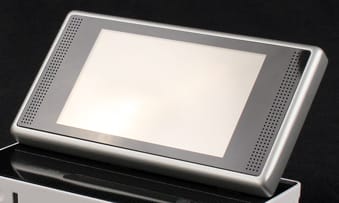
...but it turns into a nice 3-inch widescreen in playback mode.
Flash
{{section_header}}{{section.name}}{{/section_header}}
The flash on the T300 is not particularly strong, with it only able to reach a maximum of 8.5 feet when zoomed to the widest angle possible. When shooting at the full 50mm focal length, the flash's range falls to just 5.6 feet. The T300 also automatically deactivated the flash when shooting continuously, so the recycle time is very slow as the user must refocus and compose before the camera will fire a second shot with the flash. The camera does offer a natural/flash shooting mode that takes two images, one with the flash and one without, in order to get the most attractive shot.

The flash emitter pops up from the top of the body via a mechanical release.
Lens
{{section_header}}{{section.name}}{{/section_header}}
The Fuji T300 uses a 10x optical zoom Fujinon lens, with a maximum aperture range of f/3.4-5.6. From a usability standpoint the lens itself isn't terrible, but the camera is fairly slow when zooming in. The lens collapses close to the body, barely protruding from the camera itself when the camera is turned off.

The lens on the T300 offers a focal range of 5-50mm, which strikes a good balance between wide angle and telephoto. For such a compact camera, it's a solid range that will allow users to cover most typical shooting situations. There is also a 6.7x digital zoom functionality that can be activated in the menu, which allows the user to zoom up to 67x the wide focal length.
Battery
{{section_header}}{{section.name}}{{/section_header}}
The T300 uses an NP-45A rechargeable lithium-ion battery. It has a capacity of just 720mAh, however, and is only rated for around 180 shots by CIPA standards. The battery is charged using a provided standalone charger and it slots into a compartment on the bottom of the camera. The only issue we have with the battery beyond the limited capacity is the fact that it can slot into the compartment and lock into place backwards, so that the positive and negative terminals are in the wrong position. The camera simply doesn't power up like this, which will cause headaches for some customers, we're sure.

Memory
{{section_header}}{{section.name}}{{/section_header}}
The Fuji T300 takes SD/SDHC/SDXC memory cards, which also slot into the battery compartment on the bottom of the camera. The camera can shoot without a memory card in place, though there is a constant reminder that you're shooting without a card and thus the images won't be recorded, so there's little danger of going an entire day and shooting images that go unsaved.

Jacks, Ports & Plugs
{{section_header}}{{section.name}}{{/section_header}}
The T300 offers just a single connectivity port on the bottom of the camera, which works for both AV and USB output. There's no HDMI output despite the fact that the camera can shoot in 720p. The T300 comes packaged with a USB cable that hooks up to this port, though you'll have to purchase the AV cable separately (approximately $10-15 extra) if you wish to display images directly from the camera itself.
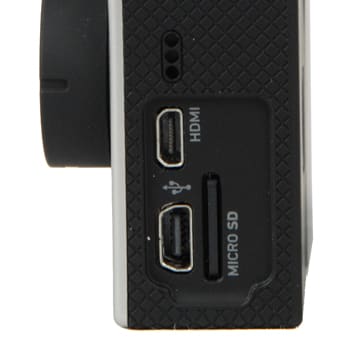
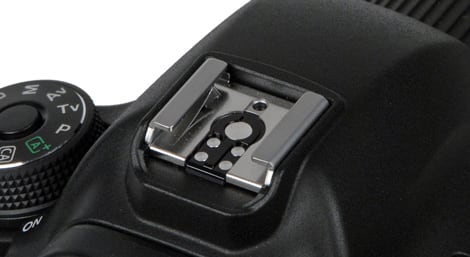
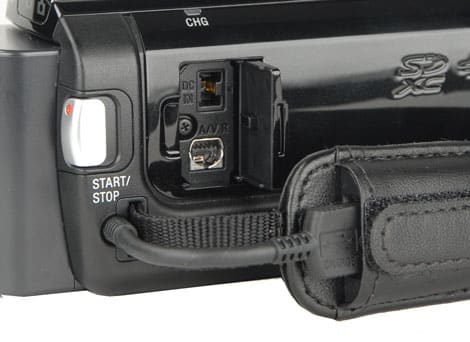
The DC-input and multi-AV port are located on the right side of the camcorder.
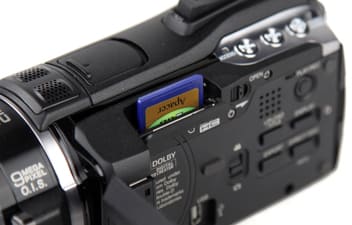
... as is the SD/SDHC card slot.
Shooting Modes
{{section_header}}{{section.name}}{{/section_header}}
The camera's rear shooting mode dial has stops for fully automatic shooting, program auto shooting, scene recognition auto, movie, natural light, natural light and flash, and two user-set scene modes. In most of the shooting modes, the only options that the user can adjust are face recognition/registration, color mode, image size, and image quality. There are more options such as autofocus method and ISO sensitivity that are available in program auto mode.

The full mode dial is nice, but frequently rotates by accident.
Scene Modes
There is no dedicated scene mode on the T300, with Fuji instead opting for two scene priority stops that the user can assign a favorite mode to. Pressing the menu key when in either of these modes brings up the scene mode list on the right side of the screen, and the user can scroll up and down this list while seeing a short description of each mode. There are 15 modes in total, including: baby mode, portrait, text, flower, party, beach, snow, sunset, fireworks, night, night (tripod), sport, panorama, landscape, and smile and shoot. The panorama mode works similarly to the sweep panorama mode in Sony cameras, in that you take one picture and then line up two symbols like a target reticle and the camera automatically takes the next image.
Picture Effects
{{section_header}}{{section.name}}{{/section_header}}
There aren't really any picture effects on the T300 in the traditional sense. The only way to alter the user's image appreciably is to utilize the Finepix Color modes, of which there are only three: standard, chrome, and black & white. The scene modes also alter color somewhat, but not in any aggressive or creative ways.
Manual Controls
{{section_header}}{{section.name}}{{/section_header}}
There are hardly any manual controls available on the Fuji T300. The only manual control the user can set is ISO sensitivity, which allows for a full-resolution range of 100-1600. There's also a reduced resolution ISO 3200 option. There are white balance presets, but there's no way to set a totally custom white balance with the camera, and no options for shifting or setting exposure manually.
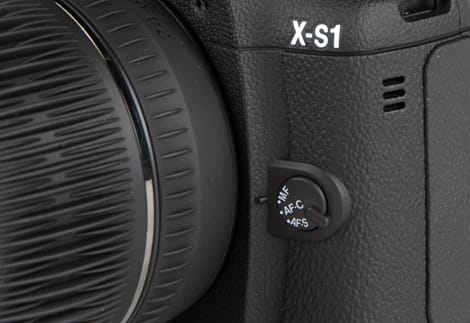
A dedicated focus-mode switch on the front panel.
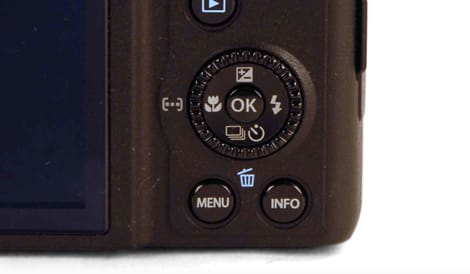
The scroll wheel surrounding the d-pad is neither awful nor perfect.
Drive/Burst Mode
{{section_header}}{{section.name}}{{/section_header}}
The T300 only offers one continuous drive setting, called "top 3" in the menu. The camera only takes a three-shot burst in this mode, and must store all three images before the user can shoot again. There are some options for self-timer, however, with the camera offering a two or ten-second delay before firing. The self-timer is set by pressing the stop-watch icon on the bottom of the rear control pad.
Shot to Shot ({{product.raw_scores['Shot to Shot Score']}})
We found the T300 fired its continuous burst at a rate of 1.2 frames per second. This is actually fairly good for a budget compact point-and-shoot, though the capacity is a pitiful three shots, after which the camera must take a few seconds to store these images to the memory card. For those three shots, however, the Fuji T300 hangs is faster than the Samsung PL210 and just a hair slower than the Fuji F600EXR. The Casio ZR100 blows the field away here, as it's designed to provide as fast a shot-to-shot time as possible.
Handling
{{section_header}}{{section.name}}{{/section_header}}
The front of the Fuji T300 is rather nondescript except for a patch of soft rubberized material that is perfect for gripping the camera. The T300 is easy to shoot with just a single hand because of this section, though there's not much real estate on the back of the camera for your thumb to rest. The natural place it falls is on the mode dial, which works for a thumbrest, except that it's easy to accidentally change shooting modes when holding the camera in such a way.

For a camera providing 10x optical zoom, the T300 is very lightweight. As such it's easy to compose with just a single hand. The lack of heft can make things a little less stable when shooting handheld at the full telephoto distance, but the lack of size and weight mean it's a camera you can easily carry anywhere.



These dedicated buttons give you quick access to aperture and shutter speed controls.
Buttons & Dials
{{section_header}}{{section.name}}{{/section_header}}
The buttons on the T300 are decent, offering decent response and an audible click when most are engaged. The camera uses a rear control pad that offers four-way directional control for navigating the menu. The shooting mode dial is a little loose, as explained above. It works as a place for the thumb to rest and pinch the camera for stability, but unless pressure is applied directly in the center of the concave dial the camera will likely slide into a different shooting mode than intended.

The T300's shutter release is also a little finicky. The button itself feels a little lose, though it does have a noticeable "half-press" stop. It requires very little force beyond that to take an image, however, and as a result the camera will frequently take a shot before it has finished focusing completely.

Menus
{{section_header}}{{section.name}}{{/section_header}}
The menu on the T300 isn't the most beautiful thing we've ever seen, but it's functional for a point-and-shoot camera. The menu is divided into two tabs: shooting/playback settings and setup. The tabs are aligned vertically on the left side of the screen, with each tab offering multiple pages of options. This will require some getting used to, as this system requires users to scroll through each page. There's no way to quickly navigate through pages using the zoom rocker as with other cameras, either.
Casio Exilim EX-ZR100 Comparison
The Fuji 600EXR and the Fuji T300 are not normally cameras you would directly compare to one another, but as one of the upper models of Fuji's line, we like to see what value you might gain in stepping up in terms of both price and quality of camera.
Given their price differences (the T300 rates at while the 600EXR, announced in August, costs ___), it's no surprise that the 600EXR offered better color accuracy, sharper images, higher image quality, and much better control than the T300. The T300 did produce lower noise totals through its ISO range than the 600EXR, though the T300 only offers a maximum ISO of 1600 at the full 14-megapixel resolution, while the 600EXR allows for shots up to 6400 ISO.
In general, this isn't a fair comparison, all else being equal. However, with the 600EXR costing $150-200 more, it's not. That being said, we feel if it's within your means the 600EXR is a better option within Fuji's line, and will offer better images, finer control, and a far less frustrating user experience in the end.
Samsung PL210 Comparison
The Casio EX-ZR100 and the Fuji T300 offer somewhat similar feature sets: 10x optical zoom, sub-$200 price point, similar compact size. The ZR100, however, offers superior image quality nearly across the board to go with its chops as a high-speed shooter.
There are generally two things users seek out when they've settled on purchasing a compact point-and-shoot camera: zoom and speed. Both these cameras offer zoom, but the Casio brings real speed. The ability to shoot upwards of 40 frames a second is a huge boon to the ZR100's cause here, but it's not just in shot-to-shot speed where the Casio runs rings around the Fuji T300.
While we can discuss things such as the T300's poor sharpness and intense sharpness falloff at the edges of the frame, it's the overall speed of using the camera that is most frustrating. The T300 is slow to take images and, once those images have actually be captured, takes a few full seconds before the user can do anything with the camera.
The entire operation thus is an exercise in frustration, one which is not necessary when shooting with the Casio EX-ZR100. With only a $50-75 price difference in the Fuji T300's favor, we simply feel the Casio ZR100 provides a better value—not to mention a more pleasing experience on the whole.
COMP 3
The Samsung PL210 and the Fuji T300 both claim to offer the "slimmest optical zoom" with their respective models, but we find the quality of a camera is measured in more than just its optical zoom power. So while both cameras give their users 10x optical zooms in a compact body for under $200, there are areas of concern in the performance of both models.
The PL210 is a slightly thicker camera, but the extra depth is worth it as it offers a superior lens that doesn't suffer from the same sharpness falloff issues as the Fuji T300. The T300 offered the better image sensor, with lower noise totals through ISO 1600, though we found its speed lacking.
The T300's user experience is well beaten by the Samsung PL210, as the Fuji is generally unresponsive and slow going from shot to shot. The T300's three-shot burst is faster than anything the PL210 can do, but after any photo there's a one or two second hitch before the user can alter any settings.
Overall, both cameras represent a great deal of zoom range for how little they cost compared to the competition. This would be great if they offered performance to match, but both cameras have their issues. If you absolutely need more optical zoom power than what your typical 5x camera offers, then these are worth investigating. For our money, the lens quality and usability of the Samsung PL210 wins out, even if the T300 outperforms it in a few select categories.
Conclusion
In our experience, there are two things most people look for when choosing their next compact point-and-shoot camera: optical zoom power and speed. While the Fuji T300 brings a healthy 10x optical zoom in a slim, compact frame, there have been obvious sacrifices made to accomplish this.
The first is the quality of the lens itself, which suffers from some of the most severe sharpness falloff we've seen out of any camera. Images that are very sharp in the center of the frame are blurred beyond recognition as you approach the edges of the frame.
The second sacrifice is in the all-important speed category. The Fuji T300 is painfully slow. The camera takes quite a while to boot up and then can only muster, at best, a three-shot burst. In any mode, the camera must store each image totally before it will allow the user to make any sort of input in the camera. This means that after every shot, there's a few full seconds of pause required before any settings can be adjusted, let alone before another image can be captured.
In most walks of life a few seconds of quiet contemplation throughout the day may do wonders for one's sanity. In the world of compact point-and-shoot cameras, however, the result is a shooting experience that's so frustrating it's bound to send a few Fuji T300s flying toward the nearest wall.
The T300 represents a desirable ideal: 10x optical zoom in a slim body that fits into your pocket for under $200. While Fuji will certainly hone this model line going forward, the first thing they may want to focus on is the user experience so the camera performs in real life as well as it does on paper.
Photo Gallery
{{photo_gallery "Front Photo", "Back Photo", "Sides Photo", "Top Photo", "Bottom Photo", "Lens Photo", "Flash Photo", "EVF Photo 1", "EVF Photo 2", "LCD Photo 1", "LCD Photo 2", "Media Photo", "Modes Photo", "Manual Controls Photo", "Manual Controls Photo 2", "Other Controls", "Buttons 1", "Buttons 2", "Other Hardware Photo", "Battery Photo", "Ports Photo 1", "Ports Photo 2", "Ports Photo 3", "Ports Photo 4", "Handling Photo 1", "Handling Photo 2", "Handling Photo 3", "Box Photo"}}
Meet the tester
TJ is the former Director of Content Development at Reviewed. He is a Massachusetts native and has covered electronics, cameras, TVs, smartphones, parenting, and more for Reviewed. He is from the self-styled "Cranberry Capitol of the World," which is, in fact, a real thing.
Checking our work.
Our team is here for one purpose: to help you buy the best stuff and love what you own. Our writers, editors, and lab technicians obsess over the products we cover to make sure you're confident and satisfied. Have a different opinion about something we recommend? Email us and we'll compare notes.
Shoot us an email
